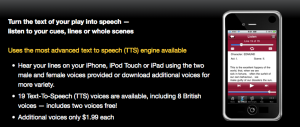ISTE Standard 3 states that teachers should exhibit knowledge, skills, and work processes that are representative of an innovative professional. My content area, theatre arts, is based in human interaction; these interactions must occur in the moment and in person. An actor must learn to act and re-act. Taking the content of theatre arts into the technological realm is equivalent to making painting class into a digital photography class. However, there is a great deal of content that can be delivered in a flipped classroom format; there are digital tools for teachers, students, and actors that are becoming increasingly common place.
Because the world is increasingly tech-enabled and tech-enhanced, how can I as a teacher of theatre arts, demonstrate technological processes that both enhance my curriculum, increase productivity, and build technological capacity in my students?
Kennedy (2009) speaks to the need for educators to rethink education and align learning environments with real world demands so that learning is flexible and can be utilized anytime and anywhere. One of the most tedious tasks of the actor is to memorize lines. One digital innovation seeks to change that. ScenePartnerApp (https://www.scenepartnerapp.com/) is one of many emerging tools for actors to use when the need to memorize their lines. Any student with an iDevice can download existing scripts or upload their own. This makes the program highly adaptable to any classroom, especially mine because much of the theatre work that my students engage with is written by the students in my classes. However, when we do get to the published works (such as Shakespeare), we can simply download the text.
One of the greatest highlights of this app is that it allows the user to hear only their lines or only the lines of their scene partner. This ability to repeat the text and use a digital scene partner is invaluable. Without this, the technique of memorization with a partner would need to happen in class. By using this app many of my students, those with iPods and iPads, have a highly effective solution that not only saves time for my classroom, it adds digital flexibility for my students. This app is one clear example of how I can integrate emerging digital technology into a classroom based on human interaction. In fact, because of the time I save (due to students memorizing their lines outside of class) I can increase the amount of human interaction in my class.
Theatre arts is not alone when it comes to time saving digital tools. Now because of the Google Institute (shared by Lida Enche in Google+) students can save travel time and virtually visit art across the world. This too increases the human interaction because in the classroom, teachers and students can talk as much as they want. Google Institute can be found at, https://www.google.com/culturalinstitute/project/art-project. I encourage everyone to check out both of these new digital tools that help arts classes.
References:
Kennedy, K. (2009). Volume 7, Issue 2 Distance Learning 21 Cross-Reference of Online Teaching Standards and the Development of Quality Teachers for 21st Century Learning Environments. Distance Learning, 7(2), 21-28.




What a great use of technology, helping your students memorize lines outside of class so you can use class time for other interaction. Your blog post is succinct and well written.
Hi David. What a cool way for a student to learn their lines! I like the idea that (since we tend to take our phones everywhere) students can have their lines in a small device with them wherever they are. This would be especially useful to a student that is learning many different things at once or would like to review what they previously learned before.